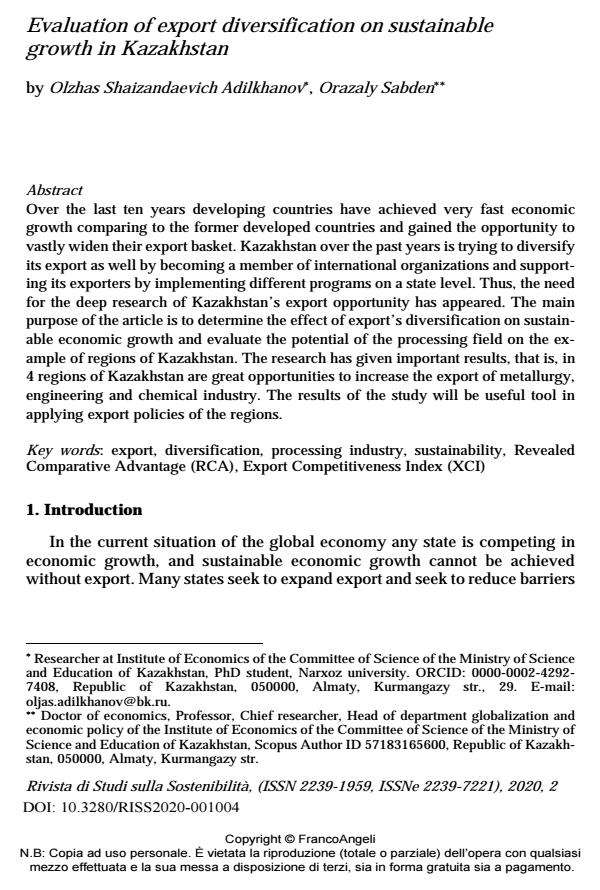Evaluation of export diversification on sustainable growth in Kazakhstan
Titolo Rivista RIVISTA DI STUDI SULLA SOSTENIBILITA'
Autori/Curatori Olzhas Shaizandaevich Adilkhanov, Orazaly Sabden
Anno di pubblicazione 2021 Fascicolo 2020/2 Lingua Inglese
Numero pagine 15 P. 49-63 Dimensione file 166 KB
DOI 10.3280/RISS2020-002004
Il DOI è il codice a barre della proprietà intellettuale: per saperne di più
clicca qui
Qui sotto puoi vedere in anteprima la prima pagina di questo articolo.
Se questo articolo ti interessa, lo puoi acquistare (e scaricare in formato pdf) seguendo le facili indicazioni per acquistare il download credit. Acquista Download Credits per scaricare questo Articolo in formato PDF

FrancoAngeli è membro della Publishers International Linking Association, Inc (PILA)associazione indipendente e non profit per facilitare (attraverso i servizi tecnologici implementati da CrossRef.org) l’accesso degli studiosi ai contenuti digitali nelle pubblicazioni professionali e scientifiche
Over the last ten years developing countries have achieved very fast economic growth comparing to the former developed countries and gained the opportunity to vastly widen their export basket. Kazakhstan over the past years is trying to diversify its export as well by becoming a member of international organizations and supporting its exporters by implementing different programs on a state level. Thus, the need for the deep research of Kazakhstan’s export opportunity has appeared. The main purpose of the article is to determine the effect of export’s diversification on sustainable economic growth and evaluate the potential of the processing field on the example of regions of Kazakhstan. The research has given important results, that is, in 4 regions of Kazakhstan are great opportunities to increase the export of metallurgy, engineering and chemical industry. The results of the study will be useful tool in applying export policies of the regions.
Keywords:Export, diversification, processing industry, sustainability, Revealed Comparative Advantage (RCA), Export Competitiveness Index (XCI)
- Hesse H. (2008). Export Diversification and Economic Growth, 21: 1-23.
- Akayeva S.A., Sokolov V.N. (2016). On sectoral and technological structural changes necessary for the modernization of the Russian economy. M.I.R. (Modernization. Innovation. Research), 7(3): 38-48.
- Cadot O., Carrere C., Strauss-Kahn V. (2011). Export diversification: what’s behind the hump?. The Review of Economics and Statistics, 93(2): 590-605.
- Cesaretti G.P., Covino D., Borrelli I.P., Viola I. (2020). Sustainability, Territories and Circular Economy. Rivista di studi sulla sostenibilità, 1: 11-28. DOI: 10.3280/RISS2020-001002
- Cirera X., Marin A., Markwald R. (2015). Explaining export diversification through firm innovation decisions: The case of Brazil. Research Policy, 44: 1962-1973.
- Fahim Al-Marhubi (2000). Export Diversification and Growth: an empirical investigation. Applied Economics Letters, 7: 559-562. DOI: 10.1080/13504850050059005
- Ferranti D., Perry G., Lederman D., Maloney W. (2002). From Natural Resoures to the Knowledge Economy: Trade and Job Quality. Washington, DC: World Bank. DOI: 10.1596/0-8213-5009-9
- Gelb A. (2011). Economic Diversification in Resource Rich Countries. Center for Global Development. World Bank, Washington DC., 55-80.
- Hakura D.S. (2009). Output Volatility in Emerging Market and Developing Countries: What Explains the Great Moderation of 1970-2003? Czech Journal of Economics and Finance, 59(3): 229-254.
- Hausmann R., Hwang J., Rodrik D. (2007). What You Export Matters. Journal of Economic Growth, 12: 1-25.
- Kodila-Tedika O., Asongu A. (2015). The effect of intelligence on financial development: A cross-country comparison. Intelligence, 51: 1-9.
- Koren M., Tenreyro S. (2007). Volatility and Development. Quarterly Journal of Economics, 122(1): 243-287.
- Lectard P., Rougier E. (2018). Can Developing Countries Gain from Defying Comparative Advantage? Distance to Comparative Advantage, Export Diversification and Sophistication, and the Dynamics of Specialization. World Development, 102: 90-110.
- Lederman D., Maloney W. (Eds.) (2006). Natural Resources: Neither Curse Nor Destiny. World Bank and Stanford University Press, 396. DOI: 10.1596/978-0-8213-6545-8
- Makhlouf Y., Kellard M., Vinogradov D. (2015). Trade openness, export diversification, and political regimes. Economics Letters, 136: 25-27.
- Mehlum H., Moene K., Torvik R. (2006). Cursed by Resources or Institutions. The World Economy, 29(8): 1117-1131.
- Ministry of Industry and Infrastructure Development of the Republic of Kazakhstan (2019). The state program of industrial and innovative development of the Republic of Kazakhstan for 2020-2025. -- [Electronic source] https://primeminister.kz/kz/gosprogrammy/industrial. (Date of access: 29.09.2019).
- Ministry of Investment and Development of the Republic of Kazakhstan (2018). Analysis of potential opportunities for export of processed products of Kazakhstan by regions. Astana. – Shanyrak – Media, 334.
- Ministry of National Economy of the Republic of Kazakhstan Committee on Statistics (2019). National Account Statistics. -- [Electronic source] https://stat.gov.kz/official/industry/11/statistic/6. (Date of access: 29.09.2019).
- Mosley P. (2018). Why has export diversification been so hard to achieve in Africa?.The world economy. 00: 1-20.
- Mаssоl О., Banal-Estanol А. (2014). Export diversification through resource-based industrialization: The case of natural gas. European Journal of Operational Research, 237(3): 1067-1082.
- Regolo J. (2017). Manufacturing export diversification and regionalization of trade: Which destinations for newly exported goods?. International Economics, 151: 26-47.
- Regolo J. (2013). Export diversification: how much does the choice of the trading partner matter?. Journal of International Economics, 91(2): 329-342.
- Sachs J., Warner A. (1999). The Big Rush, Natural Resource Booms and Growth. Journal of Development Economics, 59: 43-76. DOI: 10.1016/S0304-3878(99)00005-X
- Samen S. (2010). A primer on export diversification: key concepts, theoretical underpinnings and empirical evidence. Washington, DC: World Bank Institute, 1-23.
- Şeker A., Şimdi H. (2019). The Relationship between Economic Complexity Index and Export: The Case of Turkey and Central Asian and Turkic Republics. Ekonomika Regiona [Economy of Region], 15(3): 659-669. DOI: 10.17059/2019-3-3
- Worldbank. (2019). Kazakhstan. -- [Electronic source] https://data.worldbank.org/country/kazakhstan. (Date of access: 29.09.2019).
- Yermakova Z.A., Nikulina Y.N. (2019). Export of educational services from the border region. Economy of the region, 15(1): 191-204. DOI: 10.17059/2019-1-15
Olzhas Shaizandaevich Adilkhanov, Orazaly Sabden, Evaluation of export diversification on sustainable growth in Kazakhstan in "RIVISTA DI STUDI SULLA SOSTENIBILITA'" 2/2020, pp 49-63, DOI: 10.3280/RISS2020-002004